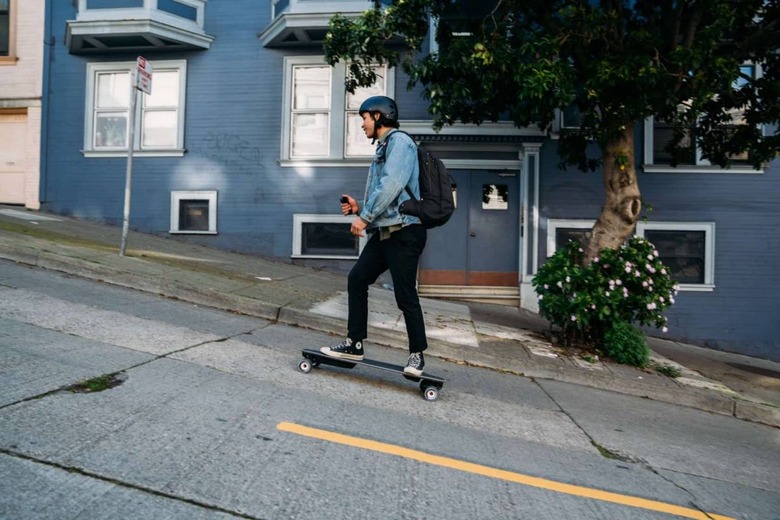How To Pick An Electric Skateboard - And Avoid Expensive Mistakes
Skateboarding is awesome, but sweating is not. Thankfully, electric skateboards have entered the scene, letting you savor the satisfying thrills of cruising around, without the discomfort of perspiration.
As long as you're confident on a board, electric skateboards are a convenient and efficient solution to the Last Mile Problem – #TFW you get off the bus and there's a mile or two of miserable walking left to do. Hop on your deck and you'll get there in no time.
Much like normal skateboarding, though, getting the one that suits you best can be confusing. On top of the usual skateboard setup, you've batteries and accessories to worry about as well. It's also a riskier purchase thanks to its higher price.

Read on for our top seven things to consider, before picking your deck – and opening your wallet.
How good are you at skating?
We're not electric board PR so we'll be straight with you: electric skateboarding can be dangerous. These things can go to incredible speeds that'll send you flying if you collide with obstacles like a curb.
If you're not too confident, single-motor boards are a sensible choice for your entry into electric boarding. Look for them at the back end of the board; there should be one single motor canister in between the two back wheels. They are normally easier on the acceleration and aren't too fast you'll fly off.
Veterans can consider double-motors, which are higher in torque and will get your zipping around places in no time.
Test the brakes
Regardless of how good you are, always test the brakes if you can. This could save your life.
Not all brakes are made well, and many electric boards suffer from sudden braking, especially at high speeds. This could cause the board to jerk abruptly, and it will be hard to keep your balance.

If possible, get up to as much speed as you can and test the brakes in a safe environment before buying. You may not be confident enough to get to such speeds, but try to get the store owners to show you.
Look out for the type of brakes available too – mechanical or electrical. Electrical brakes are more dangerous as they may be disabled if the board malfunctions. Make sure to read the instructions for a possible contingency plan if this ever happens.
Where will you ride?
Much like cars, there are boards for all sorts of terrain. Any board you pick up will get you through smooth paths and tarmac, but you may want to consider one with more torque if you're going to be going upslope regularly. And, indeed, one with excellent brakes to go down the other way safely.
If your usual route is full of cracks and poorly maintained surfaces, swap out the wheels for something a little wider and softer. The 78A – 87A range is an ideally low hardness to start with.
There are also off-road models if you're planning to skate on dirt tracks. Its wheels – tires, actually – are stuck off axles that are wider than the width of the deck, to give you even greater stability and control. If it's within your budget, these offer an even more comfortable right on bumpy roads too, virtually eating up debris and uneven roads with their pneumatic tires.
Skaters frequently going up hills might want boards with belt-driven wheels, instead of hub wheels. Belt-driven wheels are built with a pulley system that are far more powerful, although there is a bit of a resistance when you're pushing manually. Hub wheels have the motors built right into the wheels and have less power to send you up the slopes.
Lastly, wherever you ride, you'll want to make sure any board you buy is adequately waterproofed.
What kind of distance do you intend to cover?
Pushing up slopes on a skateboard is exhausting work but pushing up slopes on a heavy skateboard is maximum leg day. How long you're able to ride generally depends on the size of the battery. The more juice there is, the longer you ride.

But also look out for the quality of the battery. Depending on your weight and height, electric skateboards generally drink up 10 to 15 watt-hours per kilometre. [https://www.enertionboards.com/pages/electric-skateboard-reviews-blogs-tech-tips-buying-guide.html/electric-skateboard-buyers-guide-6-expert-tips-for-2019/] So if you're going to be traveling 12+ miles in a session, you'll want a battery with capacity more than 300 wh.
A good rule of thumb: get more than you would think you need. Weight, wind and terrain also suck up energy. You'll be glad you're not painstakingly pushing your board back the final mile – or lugging in your arms. That ain't cool.
Safety features you want
Electric boards aren't quite as grab-and-go as skateboards. For your own safety, you'll want to ensure a few things.
While not all long-boarders prefer kick-tails, the ability to pivot and turn quickly to avoid collision may save you – and someone else – some pain. Just be sure not to accelerate while pivoting.
Be sure to request for the remote before you buy as well. Ensure it has a wrist-strap and also gear selection that will allow you to toggle between different speed selections. This doesn't just let you zip up hills faster, but helps you conserve battery and maintain greater control of speed in tight areas.
Customizing your board
One reason why traditional skateboards last forever if because they are extremely customizable. Bald wheels can be swapped out easily and new ones can be found at any skate shop. New bushings, bearings and grip tape can be changed with ease, so you don't have you buy a whole new deck.

With its electrical component, modifying an electric board may be a little trickier than a skateboard. But you will want to ensure some level of customizability.
Look out for the wheels. Hub wheels are much harder to change out than traditional skate wheels, as they have a motor built into the wheel that powers it. It's much harder to find a new one to replace it when it eventually gets worn out. Wheels you want are traditional skate wheels, with nothing but bearings at its core.
Warranty woes
And because we're not all electrical engineers, chances are we'll be taking our e-boards to the store quite a bit. As great as these things are, they are notorious for breaking down and requiring light maintenance periodically.
Before you buy, do a quick Google search to check for places near you that can service your deck. Shipping it back to the manufacturer would be a hassle we'd rather not have to worry about.
Also, read the fine print carefully and check that there is a reasonable warranty attached to your purchase. There are many parts of an electric board that are prone to servicing.
Finally, check out the board to see how accessible it is for light DIY maintenance. The bolts should be easy to screw off and reattach if you ever need to get your hands dirty.
IMAGES Boosted Board
